“How can I make it simple?”
I like to write letters. When I have time, I like to decorate the envelopes with artwork.
”Nothing redeems but beauty, its generous permission,
its gorgeous celebration of all that has previously been uncelebrated.”
--Dave Hickey, The Invisible Dragon
Welcome to my art blog! The entire archive of posts can easily be found on my Table of Contents on Pinterest.
I’m also a writer. You can find seven art-related short stories here: My Short Stories
“How can I make it simple?”

I like to write letters. When I have time, I like to decorate the envelopes with artwork.
















“Art is indeed not the bread but the wine of Life.”
— William (Bill) Mutschler, Sr. (carved in the front steps of the Blue Easel)

I frequently go to the Blue Easel to get paintings framed. Bill, the owner, is the person who does a lot of the framing.* He loves to talk, and we always have interesting conversations. He is about 85 years old, and still busy and productive and full of energy. It’s quite impressive; I’m sure he has more energy than I do!
And of course, I am always pleased with the beautiful frames he builds for me. Here are some photos from a couple recent paintings he framed. Both of these paintings are available for sale.
*2024 Update: Bill has since retired and the shop is now competently run by his wonderful granddaughter Colleen. I continue to get my paintings framed there.

“Strawberries” oil on board, 8x8 inches (11.5x11.5 including frame)

“Red Tulips” oil on canvas mounted on board, 16x12 inches (not including frame)
available at Dwell Fine Art & Craft
Bill also framed this monotype below: “Muse, writing a song.” (Sold.)
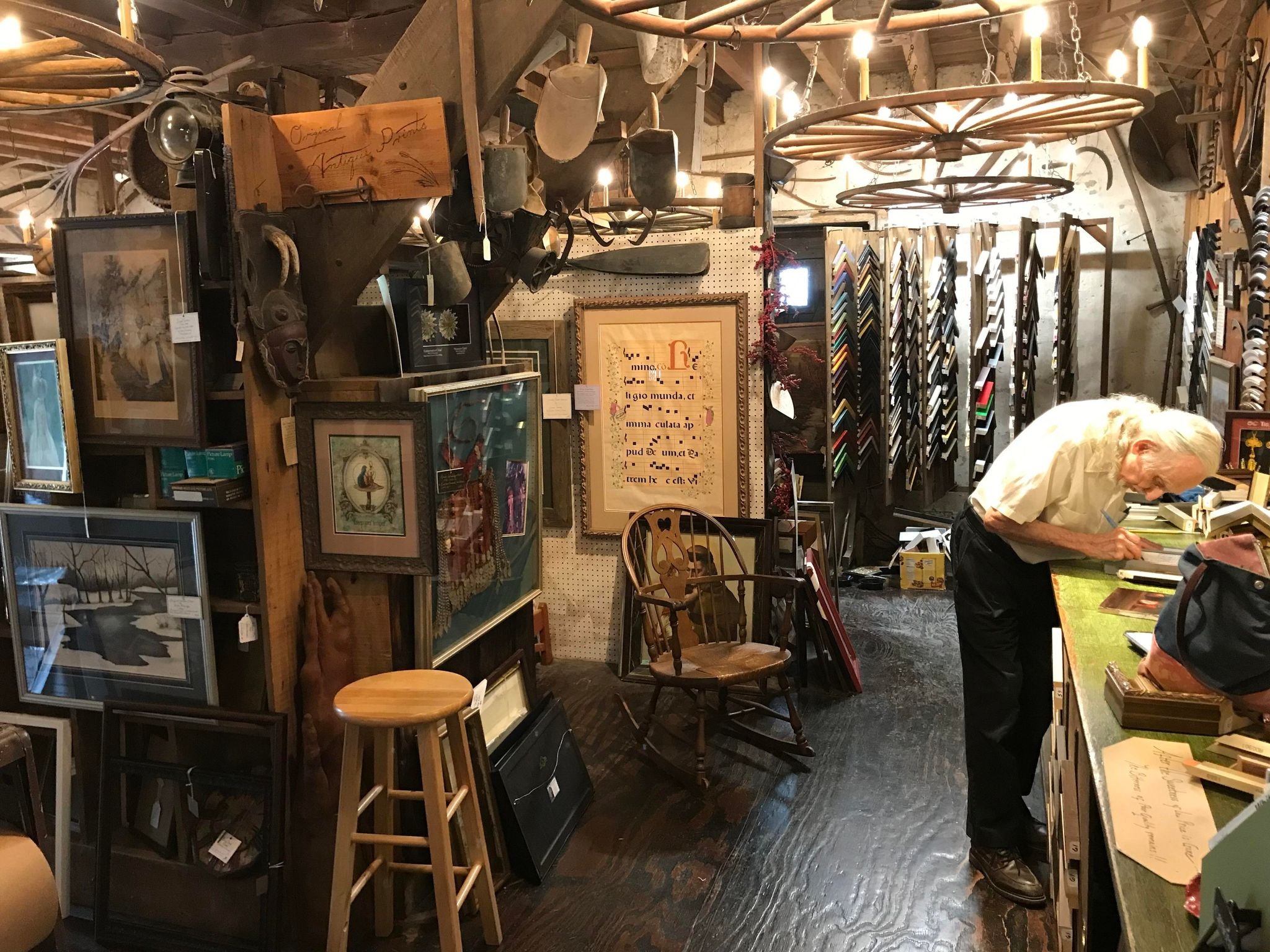
Bill, busy at his work!
The inside of the Blue Easel is fascinating, it’s almost like a museum! In addition to frames, there are all kinds of other interesting objects like antique tools and old pieces of artwork. The building itself is very old, it was once a mill. The building is close to the Bushkill Creek, and often there is flooding in that area. Two years ago there was a really bad flood and also a heroic rescue by brave emergency workers. You can read that story here. Bill told me they are still dealing with damages from that flood, but luckily nobody was hurt.

So much to see! You could spend a long time poking around…
Recently two new occupants arrived at the Blue Easel: kittens! Bella and Barney are so cute, I can’t stand it. Every time we go, my son and I love to play with them. Barney comes out more readily; Bella is shy.
(If you are interested in having a kitten of your own, Bella and Barney have four more siblings that need to be adopted. Contact the Blue Easel.)

Frame shop kittens!

Kitten and Kid, being cute
There is such a nice personal touch at the Blue Easel, and I always enjoy my errands there. I never go when I am feeling rushed, I like to just enjoy the experience and have a nice long chat with Bill. On the way out, I say goodbye to Saint Francis, an impish toddler, and a goat.

Saint Francis
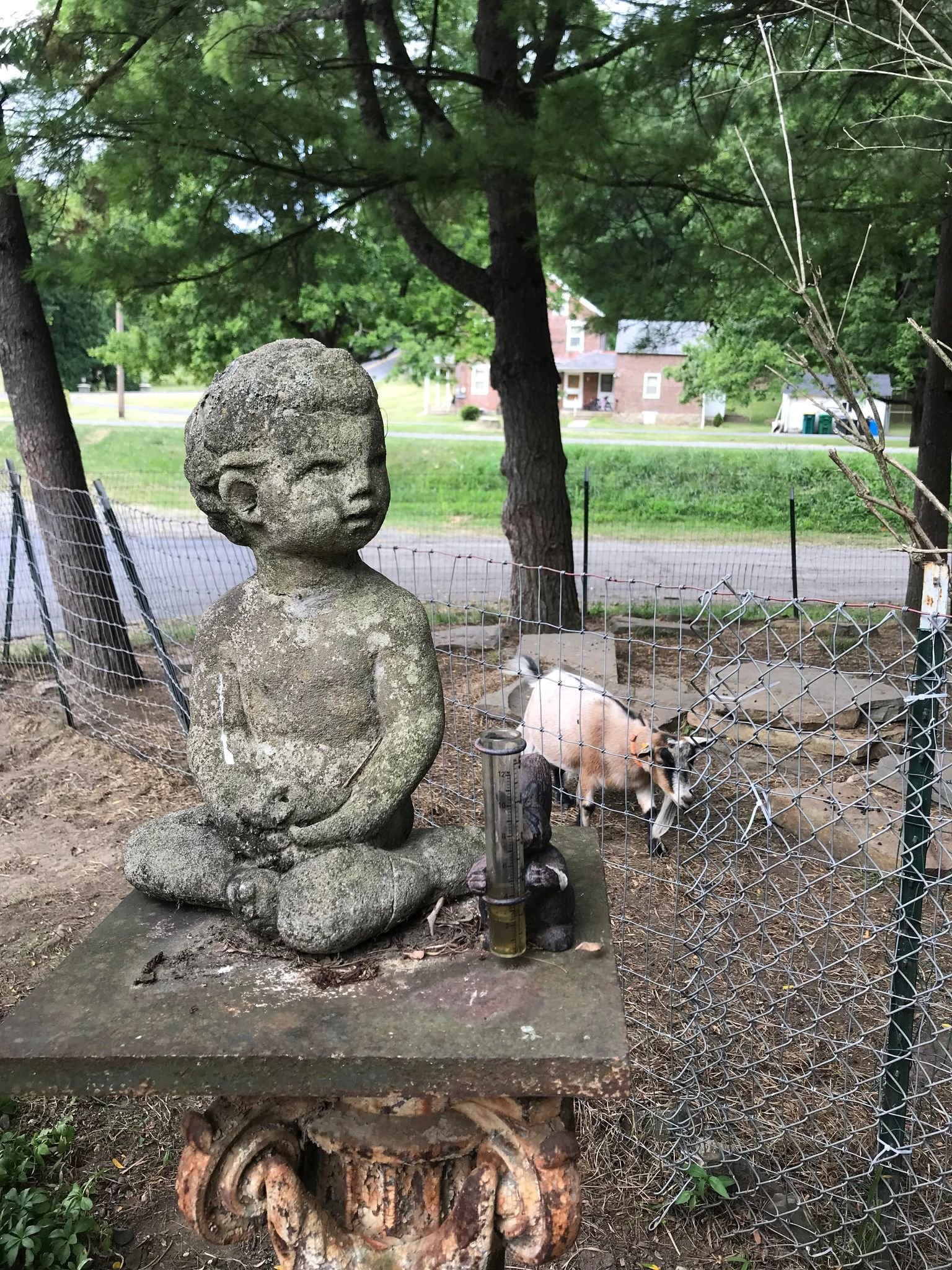
Impish Toddler and Goat
“Art is indeed not the bread but the wine of Life.” — carved in the front steps of the Blue Easel
2006 Stocker Mill Road, Easton PA, 18045
(610) 253-1131
Tuesday-Saturday 9:30 am- 5 pm

At the end of June, my 12-year-old son Morgan and I drove to Cape May to spend a few days with my sisters and parents. One of my sisters had rented a house right in the little town of Cape May, very near the ocean. We have all gone to Cape May for a week, many years in a row, with the pandemic being the exception. When I go, I love to wake up at 4:30 am to paint the sunrise.

One morning, Morgan woke up early and he came along with me! I couldn’t believe he wanted to wake up so early, but I was happy he came. He brought his new drone which he got for his birthday in March, and he used it to make this amazing video:

Morgan and me. (photo credit: kindly passerby)
It was a glorious brilliant pink sunrise. What would I do without my beloved “opera rose” paint? (Holbein Quinacridone Opera) Morgan was a great companion. It was truly a wonderful time and I was very proud of my painting. But then, as I was packing up and taking down my easel, I dropped the whole painting face-down on the sand! Luckily I was able to salvage it, removing the worst clumps of sand, and then a little bit of re-painting.
Maybe even better than before…
We packed up and walked back to the rental house, arriving before anyone else woke up. The rest of the day was spent with activities such as these: relaxing, playing with Morgan’s little cousins, working on a puzzle, napping, and going back to the beach for a swim. I made a couple other paintings at the beach that week, but I’m not quite finished with them, yet.

“Pink Sailboat at Dawn” gouache on paper, 6x4 inches
a poem by Fred Lowe
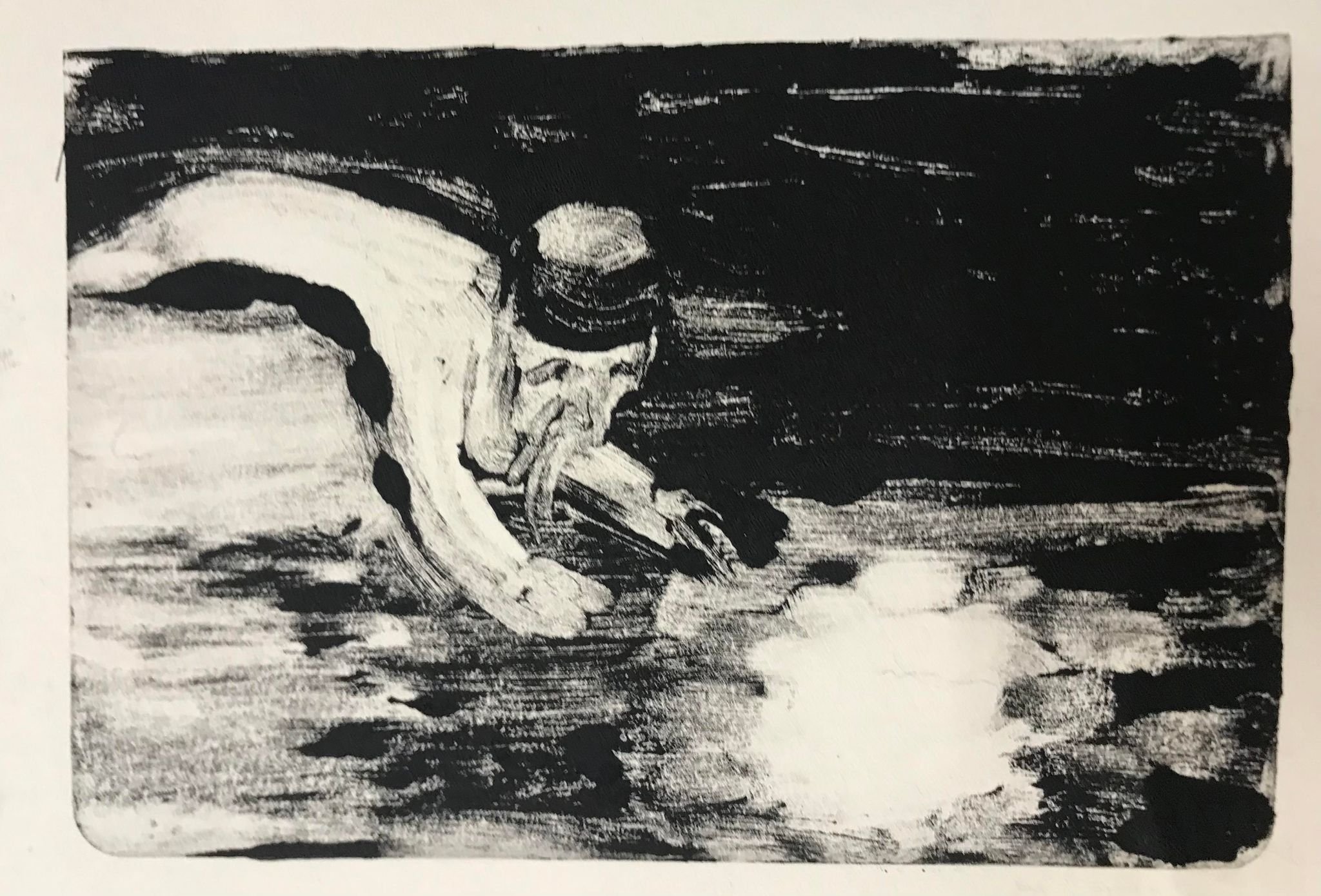
“Li-Po reaches for the moon” monotype by Lauren Kindle, 4x6 inches
Li Po #1
According to legend, Li-Po (Li-Bo, Li-Bai), one of the great poets of China’s T’ang, got drunk one night and climbed into his boat to view the moon. He rowed to the middle of the river so that the river-bank trees wouldn’t obcure his view.
The moon came with him, floating alongside the boat. Li-Po, thoroughly drunk with wine, but also with ZUI, the state of intoxication brought on by the moon’s full-faced radiance, reached overboard to grab her.
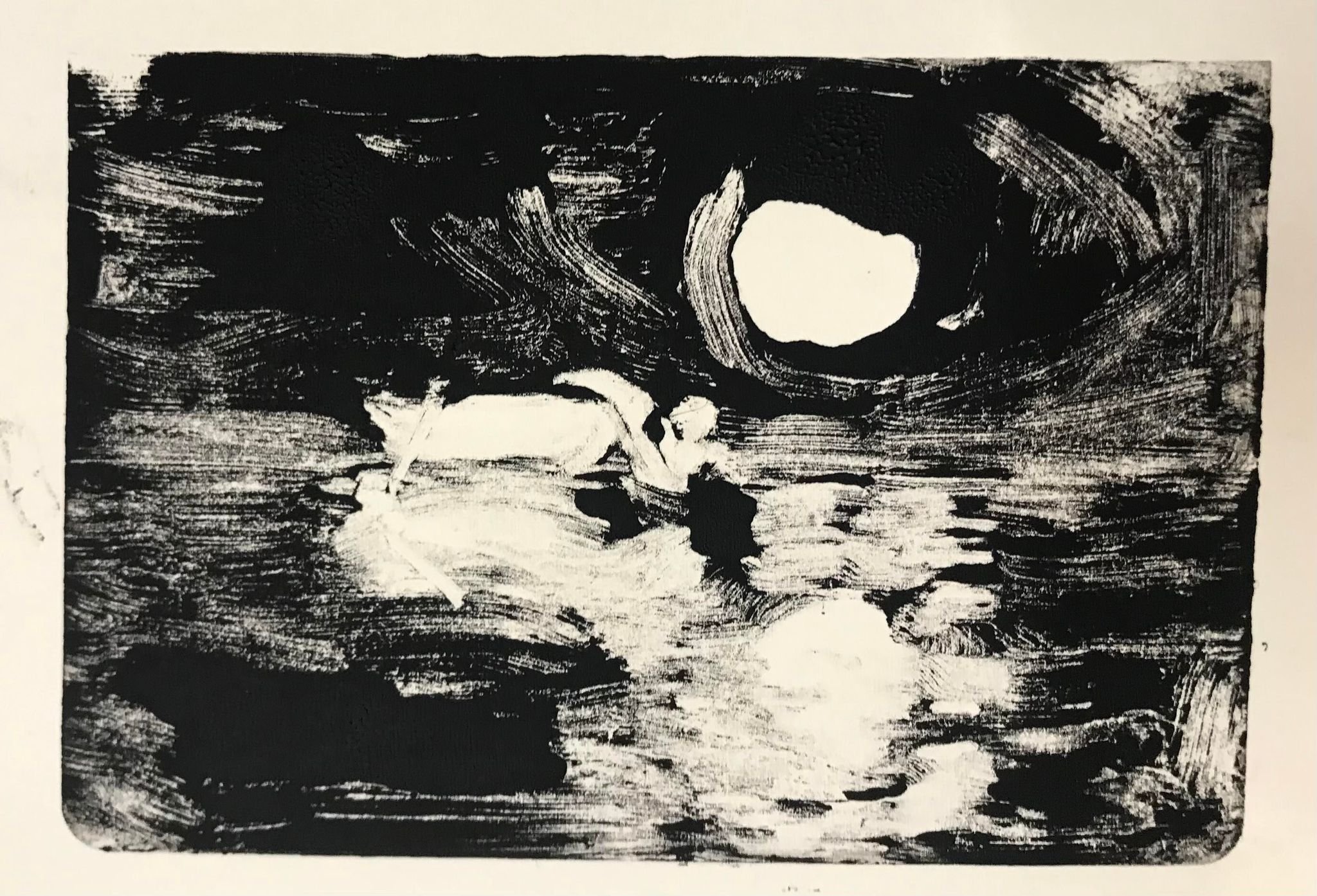
“Moon-drunk” monotype by Lauren Kindle, 4x6 inches
The boat tipped. He tumbled into the river and drowned.
Imagine his surprise: the moon disk that a few seconds before
had been drifting placidly beside him, now wobbled in shim-
mery splinters above him as the cold, black current scraped
him against the bottom stones—
With no witness, how did the story go forward?
a drifting oar
the empty boat
the sour smell of spilled wine

“Broken reflection” monotype by Lauren Kindle, 4x6 inches
“Li Po #1” was originally published in 2018 in The Moon Book, a poetry anthology. To purchase a booklet, email Fred Lowe at flowejr@embarqmail.com.
Fred Lowe: In addition to journal publications and two Pushcart Nominations, Fred specializes in collaborative projects with graphic artists. Singing Head, a hand-fabricated book illustrated by Val Sivilli, appeared in 2014. The Moon Book also with Ms. Sivilli was published in 2018. Tobar Diary, a publication of the Moonstone Press with original cover by Richard K Mills, was published the same year. Fred lives in Frenchtown, New Jersey and in Halls Mills, Maine.
The Dust Bowl of My Elbow by Margaret Campbell
Hands by Margaret Campbell
Virgil’s Muse by Margaret Campbell
In This One by Kat Good-Schiff
Masterpiece by Ian Kindle
Glutton Before Death by Lauren Kindle
My Son by Lauren Kindle
Roman Moon by Lauren Kindle
Shapes by Lauren Kindle
Edge by JD Wissler
Light of the Firefly by JD Wissler
Stars Make Their Own Space by JD Wissler

photo credit: Jillian Paige Photography
This is beautiful little note that my daughter wrote to me about four years ago, I think. So she would have been eleven years old. I love this note, and I keep it taped up on my studio wall, and I read it often. I feel very grateful and loved.

Dear Mom,
I love you a lot and I hope you feel better. Here is some advice:
Whenever you are going hard on yourself and thinking negative things, think about all the good things you have, Love yourself and believe in yourself and your art, Even when you don’t make money you are still a great person and artist, and remember that you are loved, amazing, worthwhile and an incredible person. I love you sooo much.
Love, Nell

Nell and me in the studio a couple weeks ago, during “Take-Your-Kid-To-Work” Day.

Nell’s first oil painting, age fifteen. (“Take-Your-Kid-To-Work Day”)
Having an Artist Mom (a guest blog post from my daughter when she was 9)

painting detail by Bill Barrell
I knew Bill for a long time. I first met him back in early 2007, when my husband and I first moved to Easton with our newborn daughter. I quickly befriended my neighbor, Liza, who was also a new mother with a baby girl, and we spent many lovely days wandering around Easton with our babies in their strollers.

Me and Liza at a local farm with our babies in 2007. (These babies are now 15 and 16 years old.)
The first time we stopped by Liza’s parents’ house downtown, with our babies in tow, I was immediately impressed by its beauty. The home was spacious and bright, with high ceilings and white walls drenched in sunlight which flooded in through the many large windows. Marilyn and Bill were so courteous and welcoming. Bill made us tea in a large teapot, which, along with his charming accent, made me feel like I was in England.

painting by Bill Barrell
I was amazed by the huge paintings hanging on the walls of their house. I learned that Bill was a painter, and he had a long and successful painting career behind him. During one visit, Bill showed me his studio down in the basement. I was just blown away by the power and quantity of the paintings. I also felt wistful, even sad. Something in me longed to paint too, but that desire seemed completely unachievable to me at the time.
But Bill encouraged me.
“Just do it,” he said.

Bill’s studio, open to visitors during the memorial.

painting by Bill Barrell (Liza, pregnant)
I had another baby, and I was quickly overwhelmed by the responsibilities of motherhood. It seemed even less possible than ever to paint now. But Liza told me it was possible. She recounted wonderful stories of her own childhood, and what it was like growing up with an artist dad in Jersey City. It sounded dreamy, magical, and best of all, achievable. But still, I couldn’t figure out how Bill had managed it.

painting by Bill Barrell
“Are you painting?” Bill would ask every time we brought our kids over for a visit. Liza had another baby by then as well. We were both so busy taking care of little ones.
“No,” I would say as I changed a diaper. “It’s too difficult. I don’t have time. Money is tight…”
Bill merely shrugged. “You can get very cheap paint at Home Depot,” he told me. “Ask them for the mistakes. They’re always mixing mistake colors, and they sell them cheap!” He waved his hands, to show how easy it was. Not only easy, but necessary, even obligatory.
Bill just assumed that of course one would paint. An artist just paints, that’s all there is to it. Logistics would have to figure themselves out.

painting by Bill Barrell
“But you were lucky,” I told him one day, as Bill poured me and Liza a second cup of tea.
“Luck had nothing to do with it,” Bill said, sipping his tea. “It was hard work.” He said it with a smile and a sense of satisfaction, the way a skilled laborer might talk after building a solid stone wall. Hard work, but satisfying.

Bill’s paintings and art books
Years passed, and my kids grew older and went to school. Eventually I did figure out how to be an artist. It was hard work, but I knew I was in good company. Bill continued to give me a lot of encouragement when I posted my paintings on Facebook.
“Very beautifully composed,” he wrote in a comment once. “And colors are a knockout. Keep ‘em coming!” I copied down everything he told me in my sketchbook, to read and re-read during my dark bouts of self-doubt and despair.
When I had struggles, I would reach out to him. He offered to write me a letter of recommendation for the Pollock Krasner award, a grant which he himself had won twice. I didn’t get the grant, but he kept encouraging me anyway.
“Well nothing ventured, nothing gained,” he said, when I didn’t get the grant. “Keep trying, every year.”

Bill’s art supplies
Bill also supported me by buying a few paintings from me in recent years, which helped tremendously. He continued to advise and promote me during the last years of his life. He listened to me when I told him of my struggles. He helped me have confidence in myself and my own path as an artist. He showed me how to not care too much about other peoples’ opinions and judgements.
Painting, and being authentic to oneself, was of primary importance. I’ve never met a man so confident of his vocation and abilities. He radiated confidence.

painting by Bill Barrell
“I understand, Lauren,” he wrote to me in one of his last messages. “I have been painting for over sixty years. I was a late bloomer at 25. Been through thick and thin. So I recognize where you are coming from…You are a good artist. I like the way you explore different approaches. Your drawings are graceful.” I wrote his words down in sketchbook, hungry for encouragement.
For some reason, I sort of assumed that Bill would always be in my life, a mentor, a guiding star, an example of hard work and confidence in the artists’ path. When he died, I was stunned. It just didn’t feel real.

paintings by BIll Barrell
A few weeks ago I was painting in my studio. Suddenly, I fervently wished that I could show Bill what I was working on. It was something big, something new. I knew he would be excited about it. He would really get it! But then it hit me…
I could never show Bill what I was working on, not then, not ever again. That’s when I finally cried, there in my studio with blue paint on my jeans and on my face.
I miss having someone in the world who believed in me so much. I miss him as a mentor and as a person, but I’m grateful that I had the chance to know him. It was a real gift. I feel close to him when I am painting in the studio, whenever I’m really on a roll, painting enthusiastically without any fear or hesitation. In those moments, it’s like Bill is right there, too.
“Keep trucking,” he says, smiling. “Keep ‘em coming!”

oil paints, left behind…
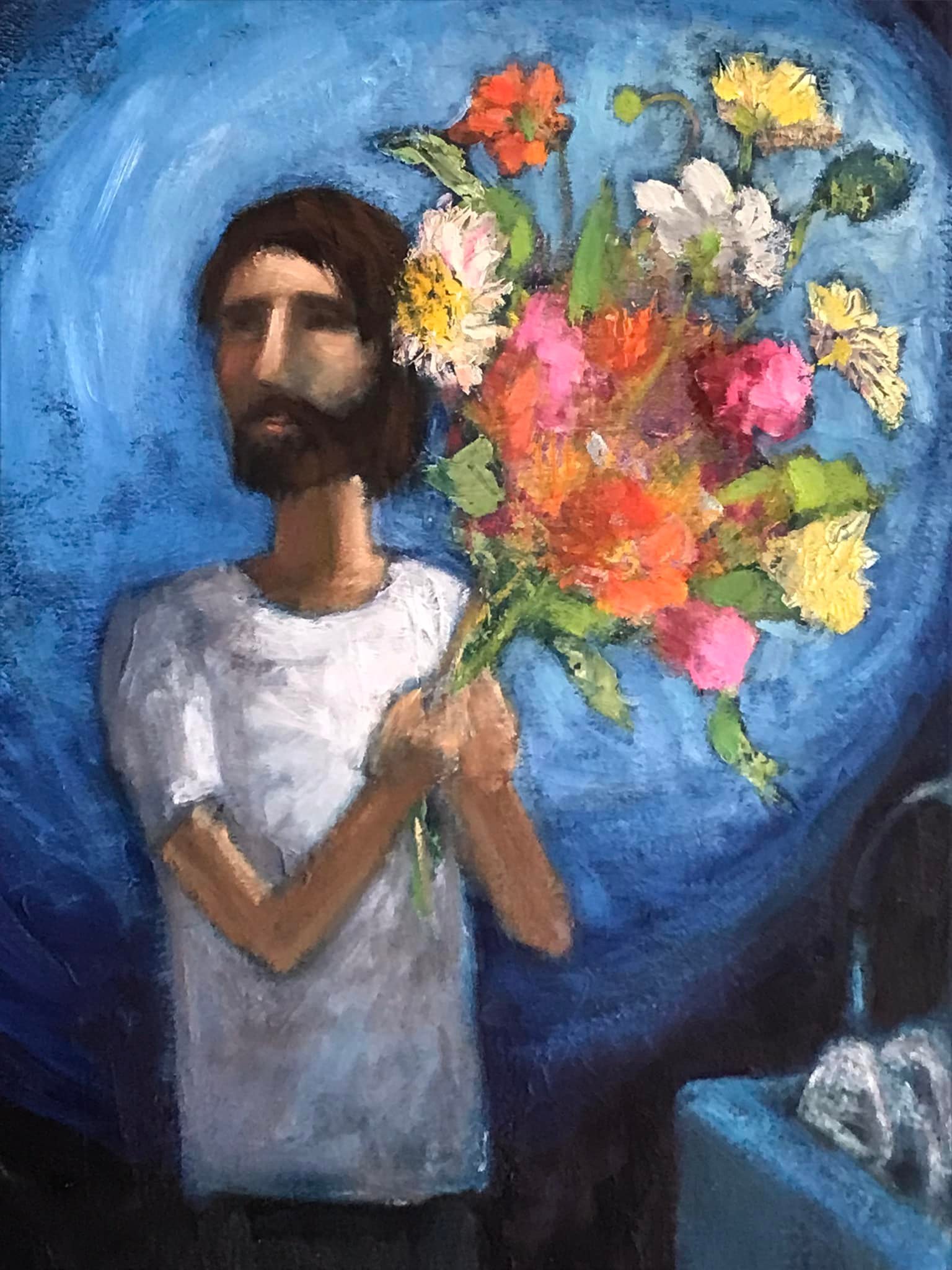
“Man with black socks and bouquet” (detail)
What does it mean to be human?
We try so hard to connect with each other.
Even when we are angry, or confused, or scared.
We offer the gift of our vulnerability, we open ourselves up to pain.
What else can we do?

“Man with black socks and bouquet” oil on canvas, 36x28 inches (sold)
I watch my husband putting on his black socks.
His familiar movements and gestures are beautiful to me.
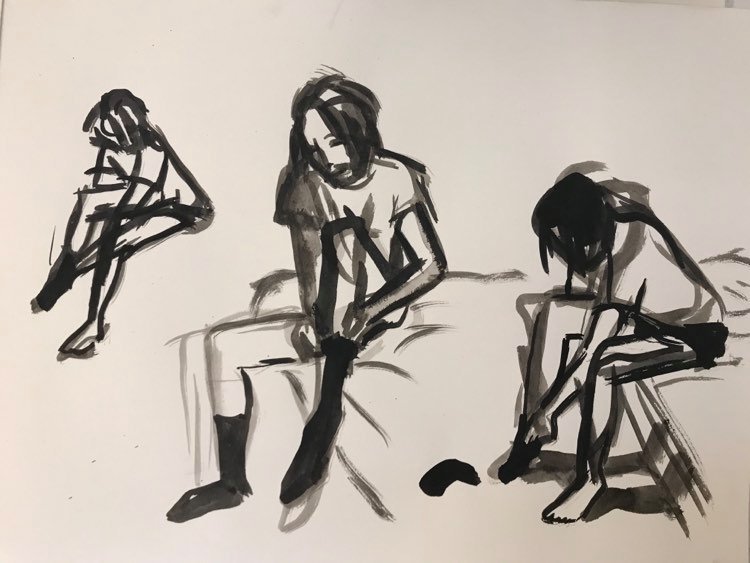
“Ian and his black socks” ink on paper, 11x14 inches
I look at Bonnard’s paintings of women putting on black stockings.
The paintings are sensual and tender, but they make me feel sad.
Life is short.
Ordinary moments become precious as they pass away.
And we are so hungry for connection.
We try so hard. What else can we do?

“Woman Putting on Her Stockings” Pierre Bonnard, 1893

“Woman with Black Stockings” Pierre Bonnard, 1900

another Bonnard painting
“…there is no difference between practice and art. The practice IS the art.” — Dani Shapiro
I’ve started painting bigger. Recently my studio mate Elizabeth gave me a large piece of canvas, which I tacked to the wall like Bonnard. I made my first marks; it was exciting!

work-in-progress near the window…and a nice spot to have tea
I’m having a lot of fun exploring a different way of putting paint down. A lot of things are different when the scale is bigger, and I have a lot to learn. My teacher Frank used to say, “Painting itself is the best teacher.” And that feels true. I am learning so much. Like how to be less controlling and to allow the paintings take their time, to slowly evolve at their own pace. It’s so satisfying to get a lot of layers of paint down on the canvas. I’ve also learned to be more patient and comfortable with paintings when they are in their awkward, unresolved stages.
I don’t always know what’s going to happen, and I don’t need to know.
I just need to show up.
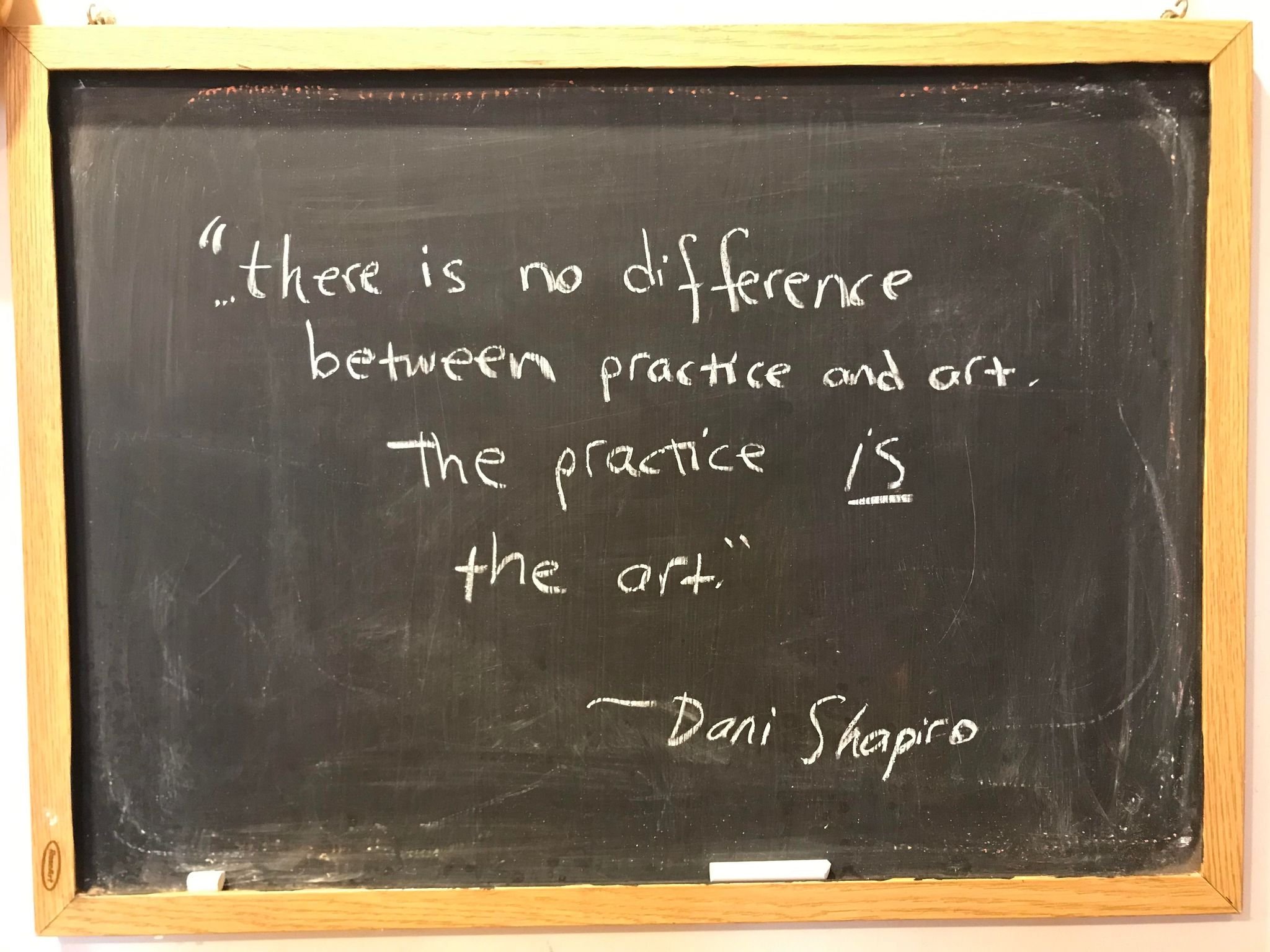
Here are some thoughts I scribbled down, from my diary two weeks ago:
Why do I want to make big paintings?
Why do I want to make narrative paintings?
Why do I want to explore the nature of oil paint in a certain way?
(well…why not?)
And also…does it matter?

“Dragon, Woman, Muse” oil on canvas (work in progress) 30x48 inches
If someone doesn’t like or approve of my paintings or my direction, does that matter?
NO.
What matters is that I am authentic to myself and obedient to my Muse.
Does envy have a place in my life? In my studio practice?
NO.
Only Gratitude.
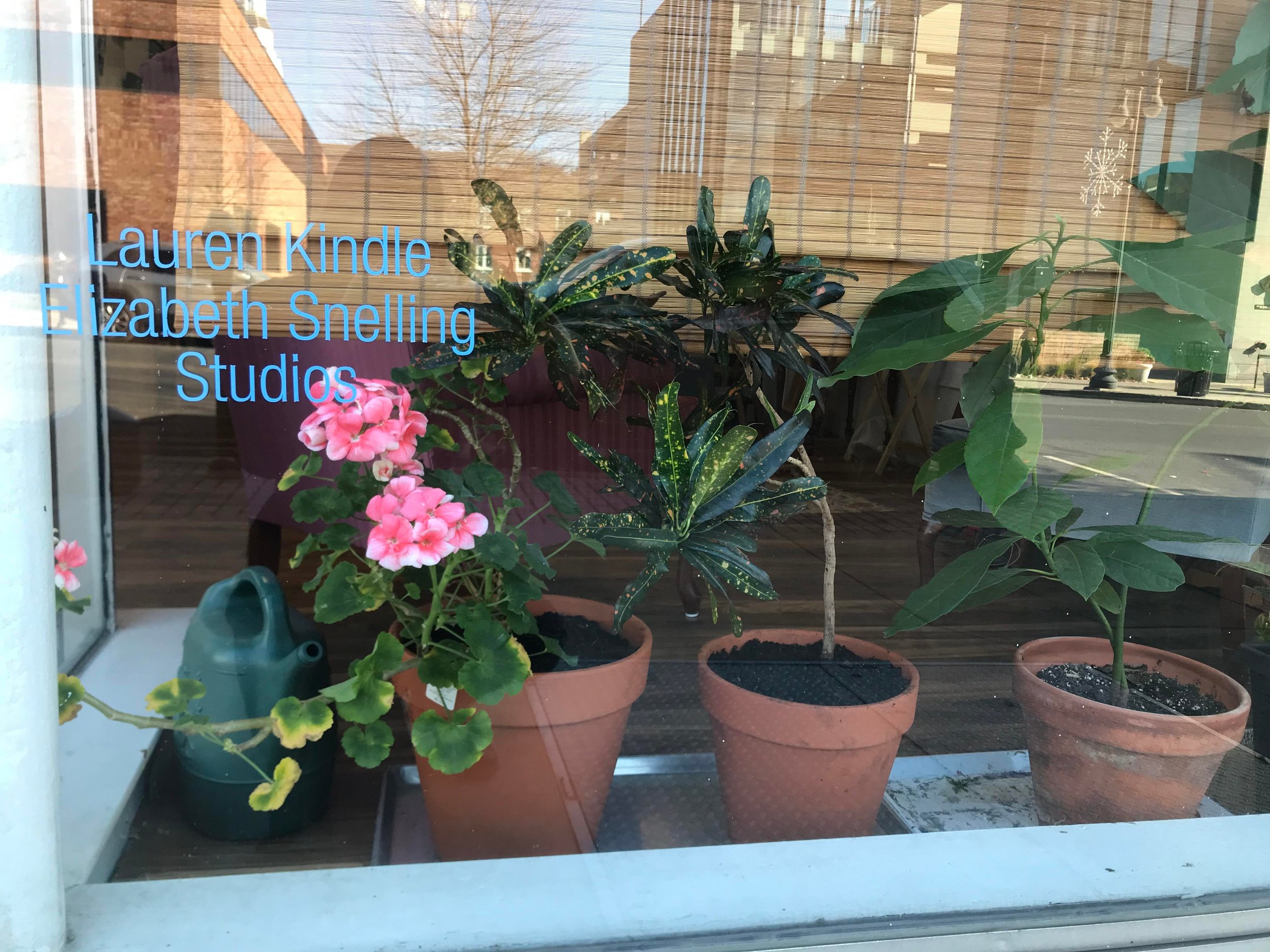
a poem by Lauren Kindle

“Small muse” monotype with additional painting, 4x4 inches
I paint for no mortal man,
Not for you, sir, or anyone.
I paint only for myself.
I paint what I want.
I paint what I—
And then the Muse speaks
(her hand gently resting on my breast)
“Oh dear heart,
Did you really believe all that?”
(and my knees give way)
—poem by Lauren Kindle

On the easel: “Standing muse” oil on canvas, 24x8 inches

“Standing Muse” detail

“Standing Muse” detail

“Standing Muse” detail

“Seated muse playing a harp” monotype with additional painting, 7.5x5.25 inches

“Greek Muse (1)” monotype, 10x8 inches

“Greek Muse (2)” monotype, 10x8 inches
four versions of an early morning sky, seen while waiting for the school bus

I’ve been struggling recently with my limited energy and motivation. I can’t seem to do all the things I want to do. Not even close. Painting feels exhausting. I love to do it, and I’m grateful for having the ability to do it. But it’s still exhausting.
I try to get into the studio most mornings for three hours. Then I have the afternoons theoretically “free” for appointments, or administrative tasks, or even a coffee date with a friend. Or that was my fantasy anyway. However, the reality is that after painting all morning, I just need the afternoon to rest before my kids come home from school.

Like…really rest. Not catch up on email. Not meet with a friend for coffee. Not work on writing a blog post.
Just Rest.
Drink tea under a blanket on the couch and pet the cat. Stare at the wall. Maybe read an Agatha Christie novel. One that I’ve already read a few times. One where I already know who the murderer is.

It’s easy to feel frustrated with my low energy and how little I seem to be able to do. Should I just forget about having friendships? Can I stop doing the laundry? How badly do we need groceries? Why does the car keep having problems? Everything feels important, and demands attention.
Often, my reaction to all the things I have to do is to shut down, curl up in a ball, and not do anything at all.
I recently read a good book by Oliver Burkeman called Four Thousand Weeks: Time Management for Mortals. I loved it! He basically reminds his readers that life is short, and it’s actually impossible to “get everything done.” It’s impossible. And that’s a relief! That means we can quit stressing about it so much. If it’s impossible, then it’s impossible. It’s no good getting angry with ourselves for not being able to do something that is impossible.

There’s a quote in Burkeman’s book which I underlined.
“…if you can step more fully into the condition of being a limited human…” then your life can be valued by “not how many people you helped, or how much you got done; but that working within the limits of your moment in history, and your finite time and talents, you actually got around to doing—and made life more luminous for the rest of us by doing—whatever magnificent task or weird little thing it was that you came here for.”
So, here’s to working within our limits with some humility and grace. Let’s celebrate our small, weird little accomplishments. It’s probably enough just to be kind, to be present, and to remember how special it is to be alive.

Paul Strand, HANDS OF GEORGES BRAQUE, VARANCHEVILLE, FRANCE, 1957, photograph
Philadelphia Museum of Art, Permanent Collection
Why was she hiding her hands?
Ashamed of her fingernails, curved
like beaks, and terrified that the bird
of death had made his nest in her lungs,
as he had. I wish I had photographed
her hands without a cigarette, or your hands
removing the tumor, the way Paul Strand
photographed Georges Braque's hands
in quiet repose on a stone the shape of
his trepanned skull. The encyclopedic
left thumb reads the letter of the burr hole.
Where have these hands been? Cross-hatched
windows of skin look out over pools
of knuckles narrating line after line
of the hands' work and the life lived.
Between the tender bed and the nails,
the quarter moon of infancy presides,
its sweet face pressed against the keratin shell.
Scaling the dorsal venous mountain range,
these hands have gripped the palms of
fellow climbers. In love's anguished mime,
they are finger birds with nerves of wire.
They could have painted a portrait
of my mother breathing the infinite sky.
— poem by Margaret Campbell
Hands
Margaret A. Campbell
Published originally in JAMA (Journal of the American Medical Association) January 2013
Poem inspired by Hands of Georges Braque, Verengeville-sur-Mer, France, 1957, by Paul Strand (1890-1976)
Other poems by Margaret Campbell:
The Dust Bowl of My Elbow
Still Life Within the Painter’s Heart
“ The brush was my friend and I was excited to see what was going to happen.”
—Irene Tatariw Trindle (my mother)

“Sheep Painting” painted by Irene Tatariw Trindle, oil on board, 8x12 inches
Lauren Kindle, an artist, and my daughter, teaches plein air painting workshops. As much as I was curious about trying one, I did not plan to sign up because the medium was oil paint and that scared me. I figured at this stage of my life, oil painting was just too complicated and expensive. For example, one tube of oil paint can cost between $5 and $25. (Editor’s Note: a tube of oil paint can cost even more than $25.)
Lauren said the workshop was just about full and she suggested I consider signing up. It was a group of women that were friends and Lauren felt that I would fit right in. She then added that she would need to ask them if it was ok if I joined the group.
Another daughter, Susan, said "you should try it".
I glumly said "It's oil paint".
Susan said I might be missing something if I didn't try it.
Lauren said "You're in if you want."
I told her I didn't know how to draw sheep.
I told her I didn't know how to paint sheep.
She said, "You will do fine."

I drove to Pipersville and I found the workshop. Everyone was there. Lauren showed us paintings of sheep by famous artists and that was inspiring. She held up books and we admired what others had accomplished, for example some paintings by Louisa Matthiasdottir.
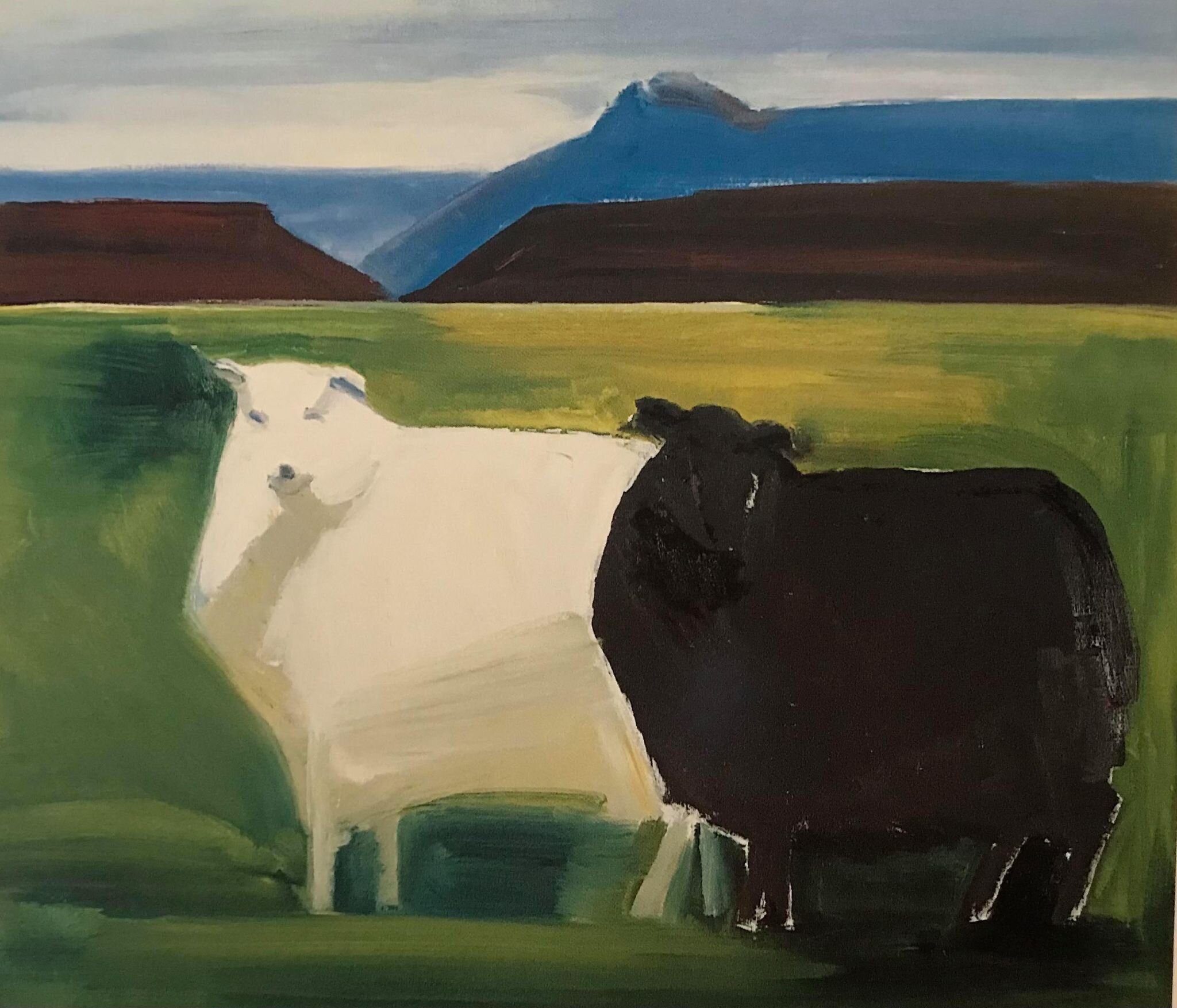
“Icelandic Sheep” painting by Louisa Matthiasdottir, oil on canvas, 31x26 inches, 1977
After introductions were made, I found myself standing under an umbrella next to the sheep corral. Lauren set me up with an easel and everything I needed. Although sheep look very much alike at first glance, they are very different. These were a rare breed of sheep and they were called Shetland Sheep. Each sheep had a name and they were different colors and different sizes.
Then we were given pieces of paper to make 3 quick sketches of the sheep. It was a good thing to do because sheep do not stay in one position very long. I actually made more sketches because I didn't like any of my 3 sketches. I stopped when I found one that I thought would work.

pencil sketch by Irene Tatariw Trindle

pencil sketch by Irene Tatariw Trindle

pencil sketch by Irene Tatariw Trindle
I was surprised that basically we were painting from our sketches, but also looking at the sheep to get the right colors and features. Since I didn't know how to paint a sheep, Lauren suggested we make rectangles for the sheep bodies and triangles or smaller rectangles for their legs. I can definitely make rectangles and triangles.

Artist Irene Tatariw Trindle at work.
Each of us was given a palette of colors and Lauren's assistant, my 11 year old grandson, Morgan, would replenish our palettes if we needed more. Lauren talked about mixing color and creating color and how we could make any color we wanted from the colors on our palette.

I was also surprised that we didn't draw on the white panels Lauren gave us. I could not believe the process. The old me would have drawn the sheep on the panel before painting them. Lauren said to look at the sketch if we needed to and start off painting the sheep right on the panel. Lauren said we could draw on the panels if we wanted but it was "fresher" if we painted directly on the panels. Also, painting on the panel was more immediate.
I found that I liked painting directly on the panel. It "flowed" out of the brush and there were no mistakes as it was all just happening. I was not filling in a drawing.
The brush was my friend and I was excited to see what was going to happen.

We painted on the panels. I painted rectangles and triangles and other shapes. I was pleasantly surprised with the oil paint; it was very forgiving and it had a texture, and with just a swish of the brush the sheep could be looking sideways or looking down or looking at me. I also liked that I could paint things whatever color I wanted. I could change things, too.
It was a very powerful feeling.

oil painting by Bonnie Tobin, workshop participant
After several hours, we were all invited to take a break and have a tea party! Tea was served in beautiful porcelain cups that had images of sheep on them! There were homemade cookies and a delicious bread.
Finally, I excused myself from the tea party saying "My painting is calling me..." I still had things to accomplish in the next hour of the workshop. We all thanked and complimented the hostess and excused ourselves. We took up our paintbrushes again.
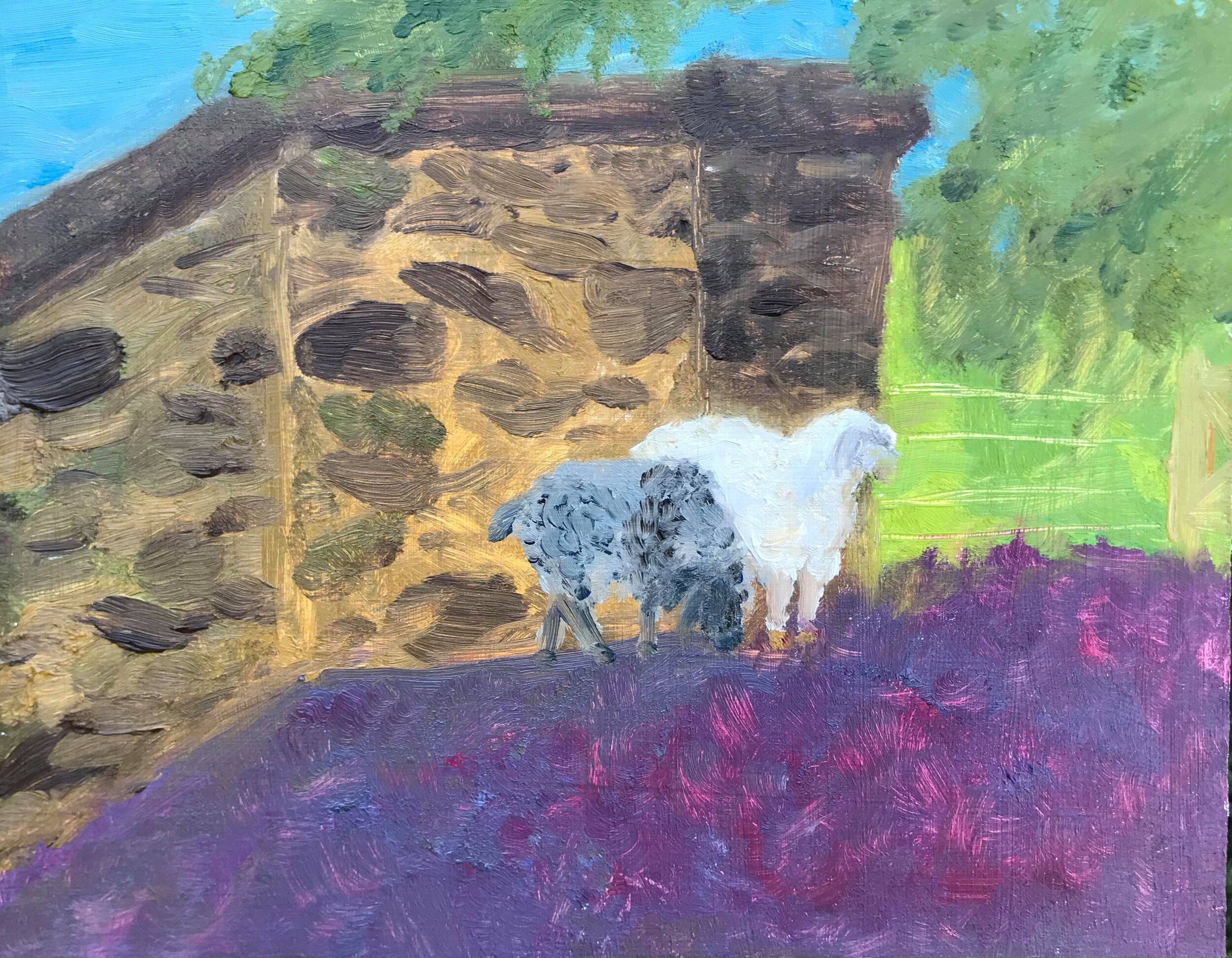
oil painting by Tina Bruzas, workshop participant

oil painting by Paula Williams, workshop participant

oil painting by Nancy Lukomski, workshop participant
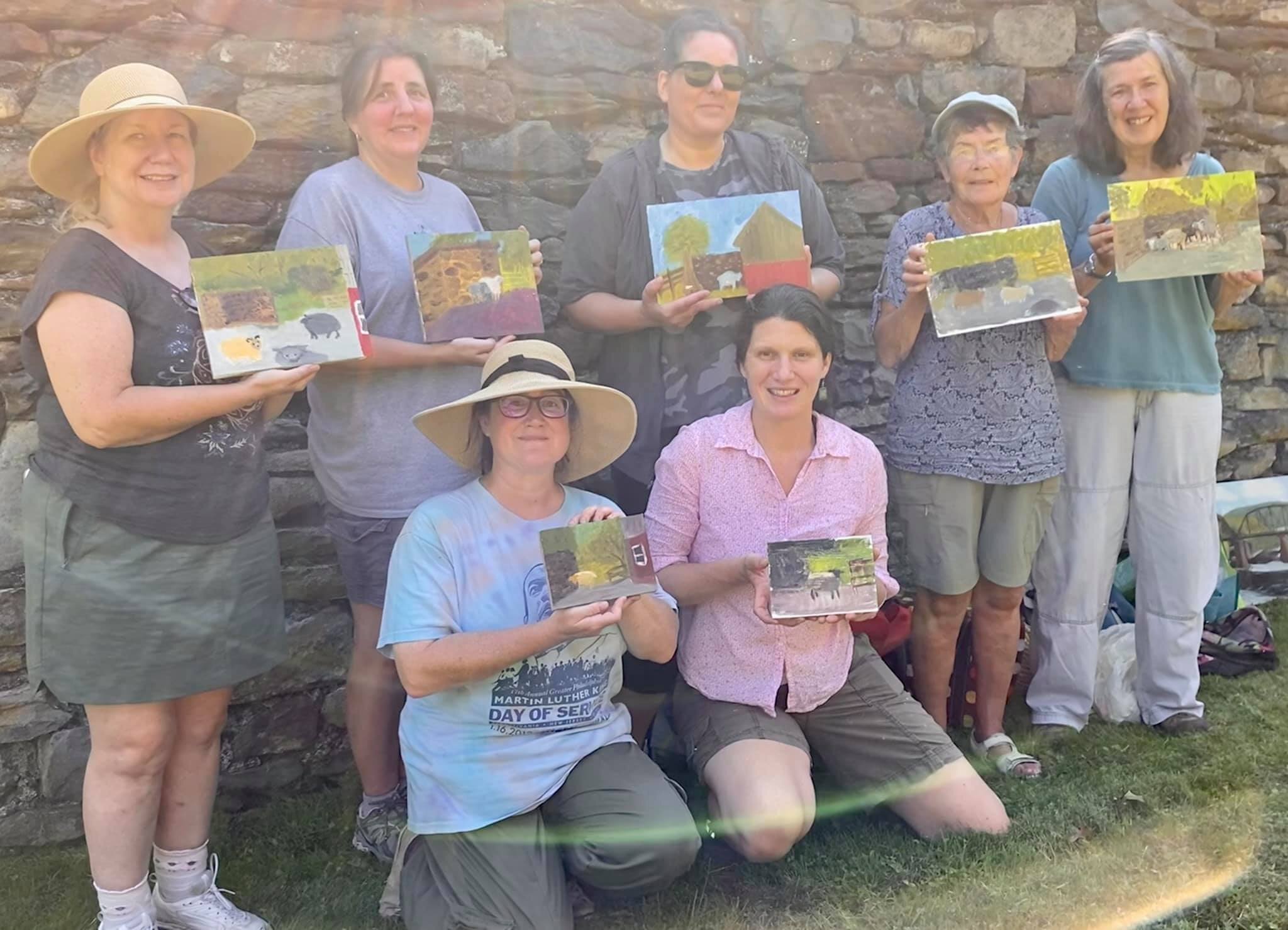
All of us completed our paintings. Lauren had each of us present our paintings. The workshop attendees and Lauren made comments on each painting. I am thankful that I had the opportunity to try out oils and on such a perfect autumn day and with such cool people. It was wonderful to see how the 8 different attendees could produce 8 different paintings that were unique in their own way. Some focused on the barn, or on one or two sheep, or on the stone wall. Some enjoyed the greens of the foliage in the background. Different things were important to the different "artists".
Of course, the painting that I liked best was Lauren's demonstration painting; it was just one sheep and it was beautiful. (Editor’s Note: “Thanks Mom xoxo.”)

“One beautiful sheep” Demo-painting by Lauren Kindle, oil on board, 5x7 inches
Girl With a Flute: another guest blog post my mom wrote about a workshop with Rotem Amizur in 2018
My Mom’s Beautiful Art: a blog post about my mom’s gouache paintings.
My son Morgan made this sweet video-montage of the workshop.
“Good art…invites us in and elevates us, as we sense the tension and resolution within the composition, and in some cases, the creative process itself. This is an aesthetic experience.”
—Jacob Janes, artist

“Bullfighter” by Jacob Janes, Oil on panel, 23.5” x 19”, 2021, Private Collection
What do you experience while looking at a painting? How does art affect you or the space it’s in?
Early on, I saw how marks on a surface added up to something greater than their sum. I felt that the images were more alive than myself. Good art does this; it invites us in and elevates us as we sense the tension and resolution within the composition, and in some cases, the creative process itself. This is an aesthetic experience.

“Untitled” by Jacob Janes, Oil on canvas, 38” x 34, 2021, Private Collection
I hope to share this with as many people as possible. It is a privilege to live with artwork which offers this type of experience daily. Artwork can define a living space and endlessly offer a refreshing and healthy perspective. This is my hope for my own paintings, whether in private collections, galleries, or museums.

“Birthday Bouquet” by Jacob Janes, oil on canvas, 23” x 18.5, 2021, Available

“Untitled” by Jacob Janes, gouache on paper, 11” x 10, Available
As an artist and educator, I want to create opportunities for myself and the students I am teaching. How can I encourage students to become artists if they are unlikely to succeed in this field or get teaching jobs? I want to find a way to educate the public on what they should expect to experience from a work of art, and why they should have artwork in their homes. Generally, what sells and what offers a genuine aesthetic experience are two different things.

“Nightcrawler” by Jacob Janes, Gouache and crayon on paper, 10” x 11, 2020, Available
The solution to this problem is to create more collectors who want work that looks good in their homes. Paintings can be affordable and they last a lifetime. There is also this funny thing about paintings, that they just sit there and I really don’t take that much time to look at them, even if they’re in my home. But they are there and they are offering something passively. They provide good, honest company. More than filling up blank walls, they challenge me to be the best version of myself, and that, to me, is something religious.

“Study of Medieval Painting” by Jacob Janes, Crayon on paper, 8.5” x 11, 2019, Available
For inquiries about purchasing a painting, contact Jacob Janes.
New Years, New Days by Scott Smith
Chris Liberti: Thoughts on Painting
Words of Wisdom from Krista Steinke
Creativity is Everything by Adriano Farinella
Laura Vahlberg Ten Tips on Painting
a poem by Kat Good-Schiff

Black Lava Bridge, Hana Coast no. 2, 1939. Painting by Georgia O’Keeffe. Oil on canvas.
Courtesy of Honolulu Museum of Art.
In This One
You stand on the brink
of another adventure.
Mom is about to leave you
but it’s not camp this time—you’re 21,
on your own in Acadia National Park
ready to hike & sunburn
drink beer & chase ravens.
You’ve climbed beyond a railing
to the edge of a rock ledge, while she calls
Do you have to go out so far? then
Turn around so I can take your picture.
You always go to the limits of her sight.
She always tries to hold you with a photograph.
You wear a purple sleeveless shirt
jeans cut off at the knee
you stand in sandals on uneven rocks
special sticky rubber strapped to your feet
with green webbing.
Your left hand leans against the orange cliff—
arm outstretched, elbow slightly bent.
Your right hand rests on your hip.
Below you, the ocean pounds.

Kat Good-Schiff
“In This One” was originally published in Quay: A Journal of the Arts
Kat Good-Schiff is a librarian and writer. She has an MFA in poetry from Goddard College, and her work has appeared in Autumn Sky Poetry, California Quarterly, Meat for Tea, PANK, and elsewhere. She lives with her wife and their animals in western Massachusetts.
Kat Good-Schiff’s blog: Dragon’s Meow: Poetry & Paying Attention
My trip to the MoMA with Kat: Kat and Picasso
“Still Life Within the Painter’s Heart” by Margaret Campbell
“The Dust Bowl of My Elbow” by Margaret Campbell
“Virgi’s Muse” by Margaret Campbell
“Edge” and other poems by JD Wissler

Cows and Artist
Last month, my friend Melissa signed up for a Cow Painting Workshop I taught at Clear Spring Farm. It was a hot August evening, and the cows were as lovely as always. I have painted them before, and I feel like we have come to an artistic understanding over the years.

Melissa was the only person who signed up for the workshop, which ended up being a very pleasant experience, peaceful and low-key. I showed her how I like to do my preliminary drawings, quickly, using only straight lines. I usually do a few of these straight-line drawings before I start painting. Here is one of the drawings that Melissa made:
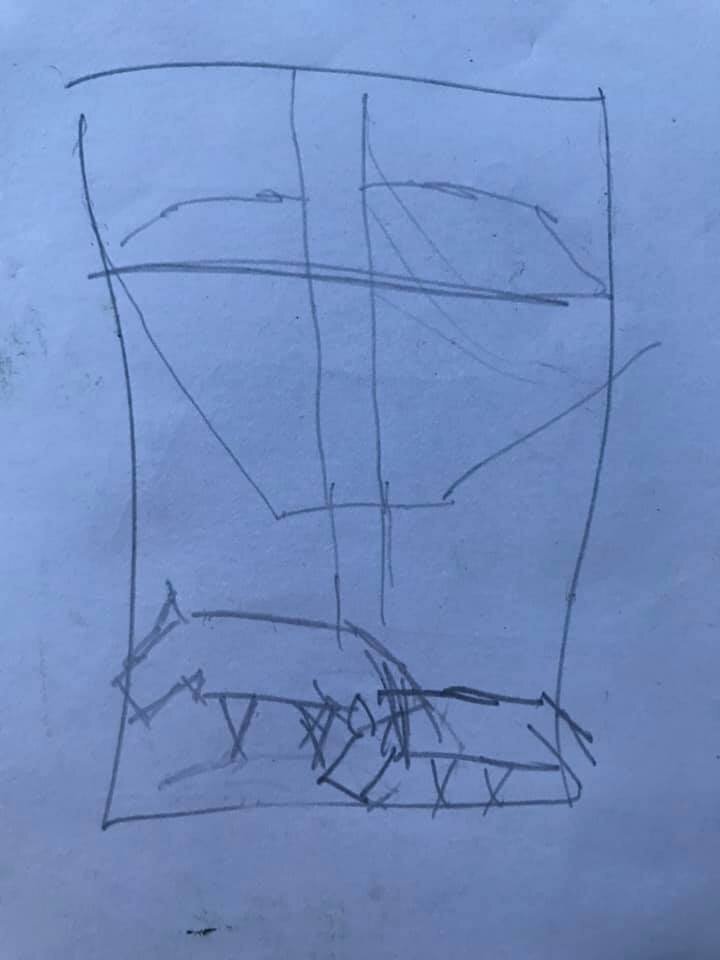
The cows were relatively cooperative. At first they displayed a great deal of interest in our painting activities, but then they wandered off. It was ok, though, because we won’t doing “super realistic” painting. It was nice to have the cows around for their energy, but we could also use our memory, our sketches, and our intuitive response to the colors and shapes that we put on the surface of the painting.
We focused on color-shapes, and the way that one color behaves next to another, the way they “talk” to each other. Sometimes, I think of it as the colors “singing together.”

Melissa did a wonderful job. She mixed several gorgeous greens, each different, and they came together harmoniously. It was a pleasure to see the brush strokes and thick paint on the gessoboard. The little white spot on the forehead of the baby cow is a beautiful detail, shining like a star in a special painting.

painting by Melissa D’Amico Mulligan, oil on board, 12x9 inches
Teaching is really rewarding. It makes me happy to see other people falling in love with the painting experience. I look forward to seeing more of Melissa’s paintings in the future.

photo credit: Katy Hunter
There’s a poem by Edna St. Vincent Millay about fruit and love, a short, elegant little piece in an anthology I have. I remember the girl who gave me this book, Miranda, a college roommate at Bryn Mawr back in the fall of 2000. I remember Miranda as a lively and passionate person, with bright shining eyes and a great deal of energy. She gave me the poetry anthology, along with her exuberant love of St. Vincent Millay. To this day, I can’t read these poems without remembering the excitement with which Miranda pressed the book into my open hands.
I was painting apples recently at my friend’s farm, and the first line of this poem rose unbidden in my mind. “Never, never may the fruit be plucked from the bough…” it was still freshly embedded in my memory after all this time, even though I hadn’t opened the book in decades.
The poem speaks its gentle wisdom: Live in the moment. Live, and love, in the moment, enjoying the fruits at hand. Now is all we have. It’s all we ever have. Don’t try to hoard up any extra sweetness for later. Only what your belly can hold.
St. Vincent Millay refers specifically to romantic love, but I can’t seem to separate that out from all the other ways of loving in my life. Children, friends, food, nature, a moment of beauty. And yes, of course, romantic love. All of it is to be experienced in the moment. Not “someday.”
It feels comforting when I remember to be present, to stay in the moment. Especially this year. It feels so difficult, and almost pointless, to make any plans. What will next month hold? Will my kids still be in school in-person? Will stores run out of toilet paper again? Will someone in my family get sick? Will people continue to buy paintings? Will my house get flooded? Will the planet be ok?
The global pandemic and recent severe weather events have shaken up my sense of security. I used to take so many things for granted. It’s all so overwhelming, it’s tempting to spin out into endless worries.
Instead of worrying, I paint.
I paint the fruit where it hangs.

Mixing colors in my friend’s little grove of apple trees…

work in progress

“Apples , ready to be plucked…” oil on canvas mounted on board, 12x9.5 inches
Finished. I think…
Here are some of my paintings currently available for sale. For more information, or to inquire about purchasing one of my paintings, email me: lauren@laurenkindle.com

“Mock Orange BLossoms” oil on canvas mounted on board, 12x16 inches

“End of Summer” oil on board, 7.5 x 6 inches

“Red Tulips” oil on canvas mounted on board, 16x12 inches, in a beautiful new golden frame (see below)

“Sunset at Cove Beach” oil on linen mounted on board, 7.25x10 inches

“Beach Dunes at Dawn” oil on primed paper mounted on board, 5.25x8.25 inches

“Jade Bowl and Blood Orange (1)” oil on canvas mounted on board, 9x9 inches

“Jade Bowl and Blood Orange (2)” oil on primed paper mounted on board, 5x5 inches

“Jade Bowl and Blood Orange (3)” oil on primed paper mounted on board, 8.25x8.25 inches

“Water Tower” oil on primed paper mounted on board, 6x4 inches

“Spring Blossoms” oil on primed paper mounted on board, 7.5x5.25 inches SOLD

“Villa Milagro Vineyards” oil on linen mounted on board, 11x14 inches (I think)

“Self Portrait Behind Flowers” oil on canvas mounted on board, 16x12 inches
“I am seeking, I am striving, I am in it with all my heart.”
—-Van Gogh, letter to Theo

I met my artist friend Kristen at an art residency in Italy in 2017. We have remained friends and pen pals ever since. Many of Kristen’s letters are filled with warm encouragement and wisdom for the artist’s journey, and I turn to them whenever I feel lost. I thought that others might also benefit from reading some of these letters, and so I had intended to publish a couple in early 2020. But the pandemic happened, and I forgot all about it. But now, as I re-read Kristen’s words this morning, I find that they still hold much value, and so I will share it with you. Enjoy!

Kristen and me at a cafe in Florence, July 2017
December 2019
Dearest Lauren,
Letter from Vincent Van Gogh to his brother Theo, about what it means to be an artist:
“I am seeking, I am striving, I am in it with all my heart.”
This is my hope for your work this new year, in writing and in painting—that is pulled forth from you with the force of being in it with your whole heart—Embodied Art— an extension of your Being (Painting as Person) from that Tom Hess quote in her book (I’ll try to find it in a second…) but I am sitting down so peacefully right now!
Your painting and writing cannot but BE YOU! So be the most enlivened, beautiful you you can be! Enjoy this turn of decade 2020! “The Gift” by Lewis Hyde. It is so very beautiful.
“What is good is given back…” The gift (art), it goes around in a circle. It comes to you and then you pass it on. In the spirit of gift giving, enjoy a gift from my bounty…Use this as a cushion to say “no” to commissions and do your heart work!
…Lean into your heart work, find your voice. Paint with freedom from it needing to garner you cash or be anything but your own free voice! Gift to the world the work of your heart, and the world will give many gifts back. I feel so wealthy, sure with money (which matters) but with a warmth of loving, so dearly, the act of painting, loving so dearly the chance to teach such eager and willing students, feeling like I’ve never ‘worked’ a day in my life— because all of it is so nourishing to me. Read this. Use this to confidently labor after your gift. Merry Christmas dear friend!
Love, Kristen

The book that Kristen sent me…
January 2020… [To Lauren]
To have a pen pal— you! I like it very much. I don’t know when I will actually get to send this letter as I am in Hilton Head, SC at the beach. My parents have a condo here that they come to all the time now that they are retired. It’s beautiful and on the ocean!…
It is hard to have ties and be “a serious” painter. I have been thinking about Grace Hartigan a lot and her “seriousness” and quick rise to fame (no… I haven’t finished the book yet [Ninth Street Women]…) It is crazy though, for all my delving into painting and knowing of a lot of painters, I really didn’t know her work until this book. I really had never heard of her, one generation passes and fame and legacy change, quickly. So fame cannot be the goal. It is fleeting, even if you score it. But, I don’t believe it was [the goal] for her. It was the pursuit of the work, which consumed her.
So, I don’t want to be consumed to the point of never choosing to have children or giving up A CHILD. (How could you?) Or losing a marriage. But I do want to be a painter, a serious and devoted painter…
I am hoping for some discipline this week to actually paint and to sneak away to read…Thank you for my letter. I loved it and plan to read it again with fresh eyes in the morning. A perspective change, from berating myself for what I didn’t to, to being generous and thankful for what I did, and simply taking in life as it comes and not sweating the small stuff.
Life creates and feeds art! The fullest us creates the fullest work. So be full! Full of family! Full of cookies! Full of walks! Full of confidence! Full of seizing the time we can in the midst of a busy life!
Love you!
Love, KP

Kristen and me, trying to set up a tent on a chilly October evening in 2019, at an art opening in Newtown, Pennsylvania.
Further reading: “Interview with Kristen Peyton”
“Art is really just a few very basics concepts that take a whole lifetime to learn.”
Last weekend I taught a private charcoal drawing lesson to my friend Il Hyun. We decided to have the drawing class at Hunter Hill CSA, a beautiful local farm just a few miles north of my home in Easton, PA. On that glorious sunny day, we chose a grove of old apple trees as our subject matter.

Artist at work.
During the class, we focused on simplification, value, and gesture. I showed him two drawing techniques that have been very helpful to me over the years: straight line drawing and reductive drawing.
Although it was Il Hyun’s first “formal instruction” in art, he displayed a lot of natural ability and enthusiasm. It was a pleasure to give him some tips and watch his drawings come to life. I feel very grateful for the experience.

Il Hyun’s “straight-line” drawing of an apple tree
If you are interested in signing up for a private drawing or painting lesson, please feel free to contact me with any questions. lauren@laurenkindle.com

“Woman Writing” gouache on envelope
I have been writing a novel for the past several years, at a snail’s pace. Early in the morning, before the day starts, my husband Ian and I sit down and write for about a half hour. (Or sometimes only 20 minutes. “Something is better than nothing,” is my guiding motto.) Ian is working on his own novel, so we write together at the same table, but on our separate projects.
Lately, I have been feeling really stuck with my plot. I’ve been spending my writing time each morning not actually writing at all. Instead, I stare in confusion at the computer screen, pulling at my hair and gnawing on the collar of my shirt in frustration, like a maniac.
I have a wonderful writer friend, Kate, and we keep touch with old-fashioned letter writing. In a recent letter, Kate suggested that I use notecards to boil down different scenes so that I could make drastic changes. So I tried, and I have spent a lot of time spreading my notes and notecards and scribbled insane timelines all over the floor, to no avail. I am still really struggling with making sense of it all.
Specifically, I have way too many subplots, and possibly too many characters who are either ghosts or gods in disguise. I also have a really intense climactic scene in the middle of the novel that should probably be near the end, where the real climax is. But logistically I can’t seem to move it there. It’s stuck in the middle, and by comparison, my actual climax is just a thin echo.
Trying harder isn’t helping, I can’t force it.
I wonder if somehow I need to “let go.”

“Writing my novel with red teapot” gouache on envelope
There are clear parallels between my writing and my painting practices. I have experienced in the studio that there is a point, if all is going well, when I need to let go of my original vision of the painting, and allow the painting itself to become an active participant in the creative process. The painting will “speak” to me, make clear how it wants to be. From then on, the dynamic changes. It is no longer a situation where the “active artist” is exerting her will upon her “passive creation.” It has instead become a mutual relationship.
A certain amount of struggling and “sweat and blood” is probably inevitable in all creative pursuits. But there’s a time for that, and there is also a time to let go, to step back, and not try to control everything. This letting go requires a tremendous amount of faith. Success is never guaranteed.
But I truly do believe that the work itself has its own spirit, and that it wants to come into being. If you let it participate in the process, magical surprises will happen!

“Me typing my novel, with flowers” gouache on envelope